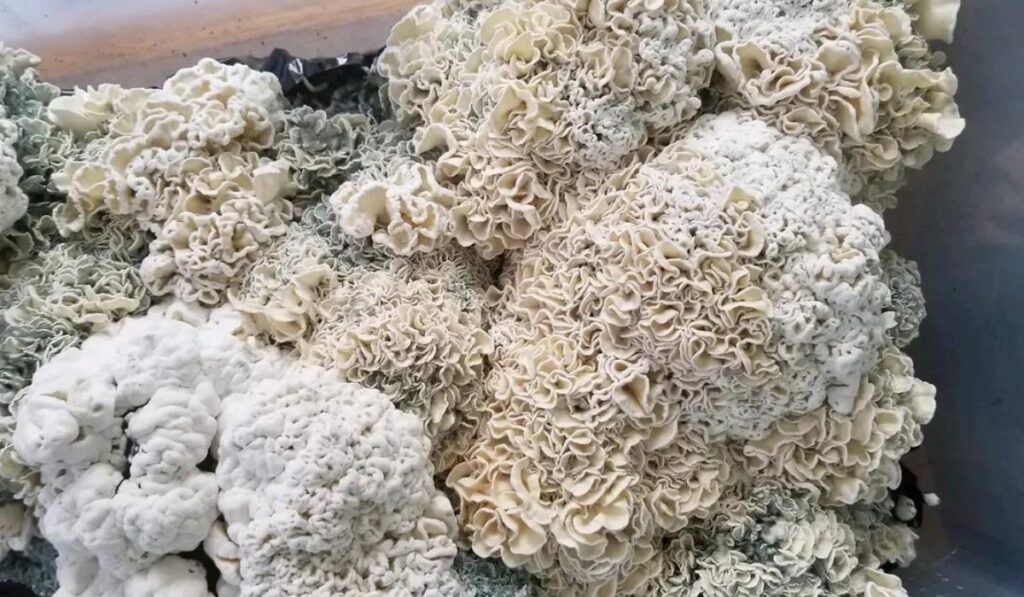The Enigma Mushroom, scientifically known as Psilocybe cubensis ‘Enigma,’ is a unique and highly sought-after variety of magic mushrooms. Unlike traditional mushrooms, the Enigma does not form typical mushroom caps or stems. Instead, it grows as dense, brain-like clusters that set it apart from other psilocybin-containing fungi. This article delves into the characteristics, cultivation, potency, and cultural significance of the Enigma Mushroom.
Unique Characteristics
Morphology
The most striking feature of the Enigma Mushroom is its atypical morphology. Rather than forming the familiar mushroom cap and stem, Enigma grows as a convoluted, brain-like mass. This unique growth pattern is due to a rare mutation, making it an intriguing specimen for mycologists and enthusiasts alike. The mushroom’s appearance can be somewhat unsettling, resembling a cauliflower or coral reef more than a traditional mushroom.
Potency
Enigma Mushrooms are known for their high psilocybin content. Psilocybin is the psychoactive compound responsible for the hallucinogenic effects associated with magic mushrooms. Due to their high potency, Enigma Mushrooms can produce intense and long-lasting psychedelic experiences. Users often report profound visual and auditory hallucinations, altered perceptions of time and space, and deep introspective insights.
Cultivation
Growing Conditions
Cultivating Enigma Mushrooms requires specific conditions to achieve optimal growth. They thrive in a controlled environment with consistent temperatures between 70-75°F (21-24°C) and high humidity levels around 90%. Substrates such as brown rice flour, vermiculite, and coco coir are commonly used to provide the necessary nutrients for growth. Given their unique morphology, Enigma Mushrooms do not produce spores, making them challenging to propagate. Instead, they are typically cultivated using tissue culture or mycelium transfer techniques.
Challenges
One of the primary challenges in cultivating Enigma Mushrooms is their susceptibility to contamination. The dense, brain-like clusters provide ample surface area for bacteria and mold to colonize. Maintaining sterile conditions throughout the cultivation process is crucial to prevent contamination and ensure a successful harvest. Additionally, the lack of spore production means growers must rely on cloning methods, which can be labor-intensive and require advanced mycological knowledge.
Cultural Significance
Historical Context
Magic mushrooms, including Psilocybe cubensis varieties, have been used for centuries in various cultural and spiritual contexts. Indigenous cultures in Central and South America have long utilized psilocybin mushrooms in religious ceremonies and healing practices. While the Enigma Mushroom itself is a relatively recent discovery, it carries the legacy of these traditional uses, offering modern users a connection to ancient practices.
Modern Use
In contemporary society, Enigma Mushrooms have gained popularity within the psychedelic community for their unique appearance and potent effects. They are often used recreationally to explore altered states of consciousness, enhance creativity, and foster spiritual growth. Additionally, recent research into the therapeutic potential of psilocybin has renewed interest in magic mushrooms, including the Enigma variety, for their potential to treat mental health conditions such as depression, anxiety, and PTSD.
Conclusion
The Enigma Mushroom stands out in the world of magic mushrooms due to its distinctive morphology, high potency, and intriguing cultivation challenges. While it may not have the same historical background as other psilocybin mushrooms, it carries significant cultural and modern relevance. As interest in the therapeutic and recreational use of psilocybin continues to grow, the Enigma Mushroom is poised to remain a fascinating subject for mycologists, cultivators, and psychedelic enthusiasts alike.







